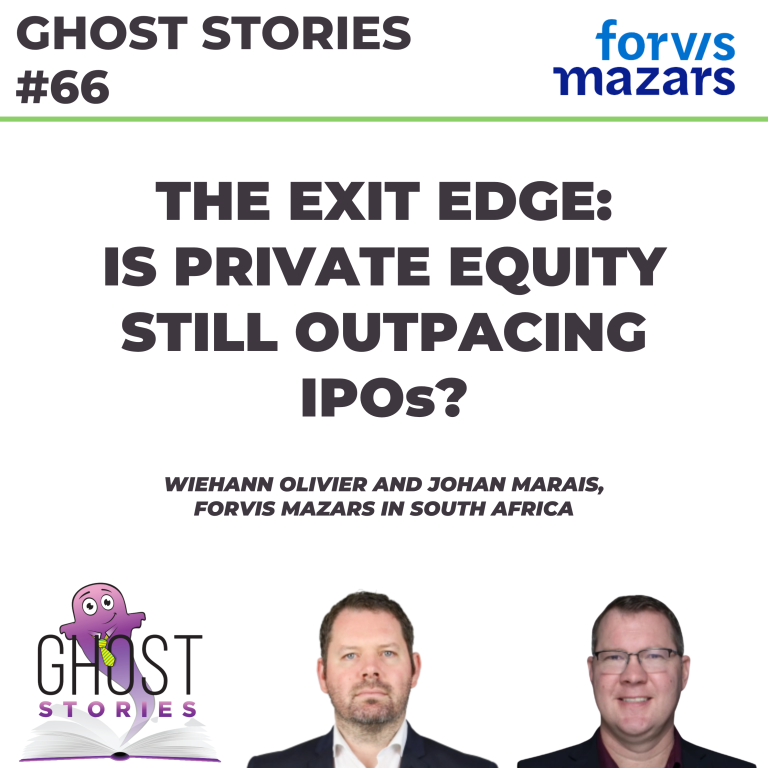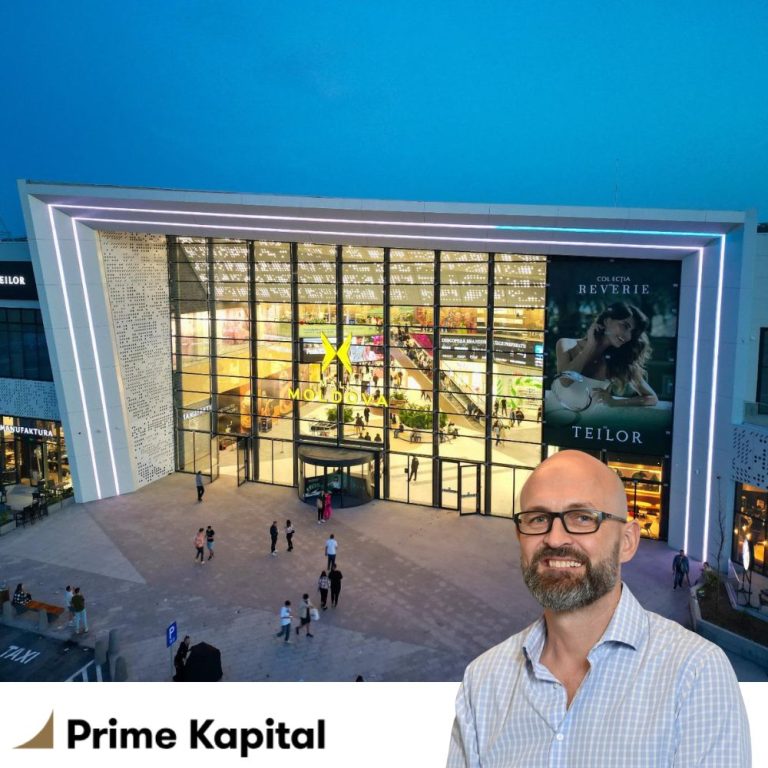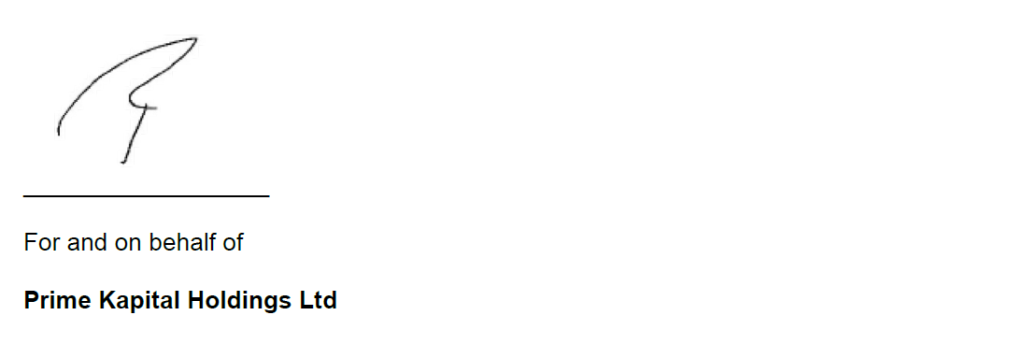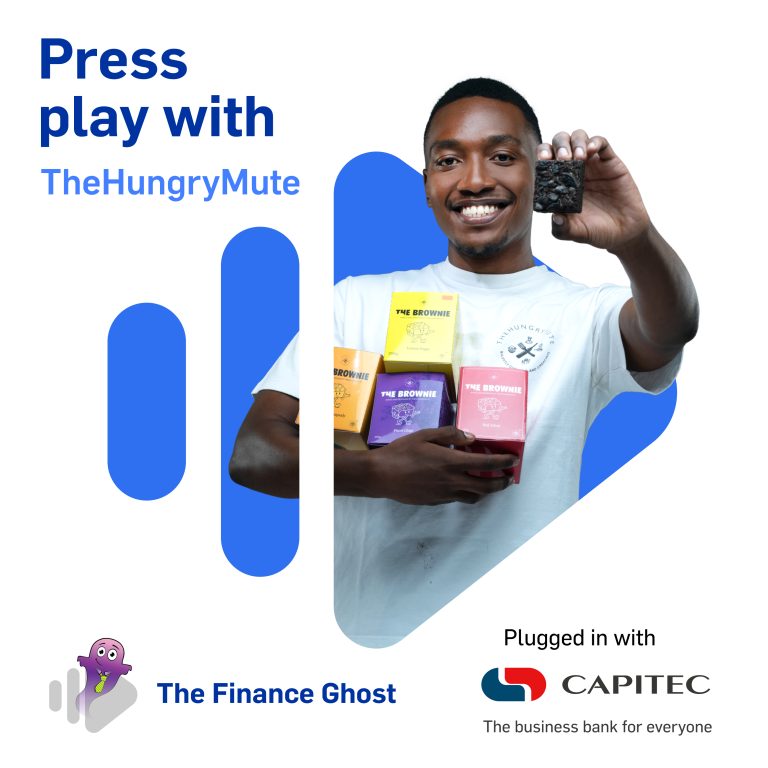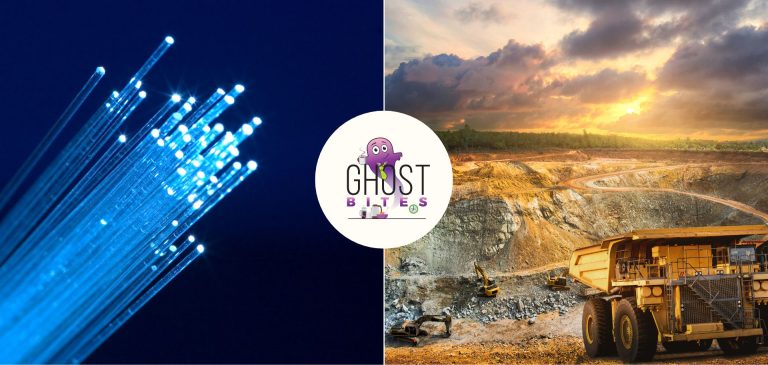The latest C-suite Barometer study by Forvis Mazars paints a positive picture for private equity and alternative investments, with 26% of global executives planning to use these channels to raise funds in the year ahead. South Africa is no different to the global trend here, as evidenced by the extent of exits and capital raising transactions in private vs. public markets.
But why is this the case? And will private equity continue to outpace IPOs as the exit mechanism for choice?
To unpack these topics, I was joined by Wiehann Olivier and Johan Marais of Forvis Mazars in South Africa.
Listen to this podcast if: you want to understand the structural advantages that private equity has over public markets, particularly for mid-sized companies.
Listen to the podcast here:
Transcript:
The Finance Ghost: Welcome to this episode of the Ghost Stories podcast featuring the team from Forvis Mazars in South Africa. And I must say I’m looking forward to this one because we’ll be covering a topic that is quite close to my heart, actually, which is private equity.
I always find myself fascinated by all the different investment vehicles that are out there and how companies raise money and how investors can find those opportunities and just the whole ecosystem around that, obviously, where Forvis Mazars plays as well.
We’ve got some really experienced voices on the podcast today. So first up, we have Wiehann Olivier, who is a Partner and Head of Fintech, Digital Assets and Private Equity for Forvis Mazars in South Africa. Wiehann, a nice short title there always makes it easy for podcast hosts. Thank you.
And Johan Marais, who thankfully does have a short title, which I’m most appreciative of, which is Partner: Corporate Finance. Short and sweet.
So, Wiehann, you seem to do a whole lot of different things, and Johan, I don’t doubt that you – given my experience in corporate finance as well – get to see a bunch of different sectors. It’s lovely to have you both on the podcast today. So welcome to Ghost Stories and I’m looking forward to having some fun.
Johan Marais: Thank you, Ghost. Nice to be here.
The Finance Ghost: Yeah, it’s going to be good. So a lot of this is coming from this C-suite Barometer, which is the study by Forvis Mazars, which I think covers a bunch of different topics. I’ve seen some quite interesting stuff coming through. It seems to be basically what is top of mind for execs, which is obviously a really interesting set of insights for you to bring to the table.
And one of the insights that came through was that it paints quite a positive picture for private equity, for alternative investments – I think the quote from the study was that roughly a quarter of global executives are planning to use those channels to raise funds in the year ahead. Now, I know from discussions with others in the market, alternatives have certainly exploded in popularity. It is all very, very interesting.
So, before we dive into some of the insights and questions, I was just curious whether what you saw come through from the C-suite Barometer was actually in line with what you expected? Was it perhaps even more positive for private equity than what you thought?
Wiehann, maybe let’s start with you and then we can get some thoughts from Johan on that?
Wiehann Olivier: Yeah, sure. So as you mentioned, that global private equity report, we called it Riding the Wave of Market Change, that was released earlier this year. Now effectively what it does is that report summarises findings from Forvis Mazars’ global private equity survey. I think it’s over 300 respondents.
So it was interesting to see – and there was quite a bit of feedback also from South Africa and the African region as well, just to see what the overall market looks like from a private equity standpoint. I think from my perspective and where it was interesting to see is the focus on various types of investments or underlying assets that these private equity funds are investing in.
But as you mentioned as well, it’s almost like a focus more on the private equity – we had in the past that there was a lot of people looking to raise funds who went the traditional route of listing their stocks on a local stock exchange. And that seems to have changed over the recent years, various reasons as well. That was specifically one of the areas that I found more interesting.
But also, from that point of view is seeing some of the challenges that various other regions face when dealing with private equity and the outlook of various types of investments. I mean, we’ve got our challenges in South Africa, but it’s also interesting to see that various other regions have similar challenges that we experience in South Africa and are very unique and different types of challenges also that we’re not faced with on a day-to-day basis in South Africa. So I think those are the two areas that stood out most for me.
And I think for us focusing on private equity as extensively as we do, it’s always fantastic to see there’s a larger focus on that going forward as opposed to, if I can call it, the era of listed types of investments.
The Finance Ghost: Yeah. Johan, I’m curious to get your thoughts on whether or not that survey came in with your expectations as well?
Johan Marais: Great, thanks Ghost. I must say there’s always a bit of surprise in these surveys as well. But it also depends on the population of the survey respondents. And I think in this instance it’s been quite good. It’s not just South African respondents. Quite a global one, how it feeds into our business that we do on a daily basis.
It’s great to understand exactly where our clients are seeing private equity. And it’s changed quite a bit I would say over the last four or five years – how much capital is being raised, how is it being raised, the exit profile of these assets – and that leads also into our wider offering as well, especially in our audit base that targets private equity. Because if you want to target a certain industry, certain clients, you need to understand what’s happening globally, what’s happening locally. And that’s given us great insights. Well, so we certainly take that information on board when we service existing clients, whether it’s private equity, or whether we target future clients as well.
The Finance Ghost: Yeah, it’s super interesting. There is a lot of value in actually getting out there and doing that market sounding and understanding what is top of mind for these execs. At the end of the day we can sit and guess, but if you’ve got the data to back it up, it’s just so much more interesting, right? It really does show you what’s going on out there.
And speaking of data, I think the trend that has been pretty clear in recent years, aside from that Covid frothiness when interest rates were super low and there were just tons and tons of IPOs, you get those sort of top-of-the-cycle bubble periods where there’s lots of IPOs. But if you take that noise out of the data, I think the recent trend has very much been a lack of IPOs, especially outside of the US – and just for those who might not understand that term, an IPO, initial public offering, basically the process of a company coming to a public market for the first time, raising capital from the public. It’s a very exciting thing. They ring the bell, they hit the gong, they do whatever it is they do at the exchange, blow the horn and raise money. And that’s what bull markets are all about, right, is IPOs and new opportunities and everything else, at least historically.
But these days, especially outside of the US there’s less of this happening. And I would imagine that even in the US there would be more IPOs, were it not for the very real alternative of stuff like private equity.
So would you say that that trend is something that you’ve observed as well? You touched on it a little bit Wiehann in your answer about your expectations, or rather how the C-suite Barometer came through in terms of your expectations, but I’m interested to actually just get some more thoughts on that point specifically, because I personally don’t think it’s a trend that’s going to change. I think it’s only going to get worse.
Wiehann Olivier: Yeah, no, 100% agree with you. Absolutely. You can see there’s a global trend and also something that we see locally. I think the decline in IPOs is not necessarily due to a lack of investable companies but rather because more firms are choosing to stay private. I mean private equity offers greater flexibility, less regulatory overhead and strategic partners that take a long-term view on the underlying business.
I think that’s something that the public market just doesn’t simply provide. Even if you look at the cost and the admin associated with certain elements of being a listed entity, it becomes quite significant at the end of the day.
And I think that unpredictability of public markets has pushed many founders towards private capital – heightened volatility, those complex listing requirements that we spoke about, elements such as geopolitical pressures – going public has become burdensome at the end of the day. And I think private equity investors allow funders to focus on scaling their business instead of meeting those short-term earnings expectations.
We saw that coming through in the report as well. There’s an increasing interest in mid-market transactions and these are typically below the radar of public markets but are highly attractive for private equity funds, especially those with operational expertise. And I think it’s a space where private equity firms can drive real value without the noise of those quarterly reporting cycles.
But I think, in my view, private equity allows for more, almost you can refer to it as “patient capital” – especially during those uncertain exit windows. The report showed that the holding periods are extending beyond the traditional three to five years as well with many firms opting to hold assets longer to ride out the various cycles. And I know there are various jurisdictions and countries with elements of uncertainty. It’s almost become like a seasonal thing and this offers them just a mechanism to optimise those exits as well. I think in my view ultimately private equity provides the right balance of strategic input, capital access and value creation. For companies in growth mode, especially, those navigating uncertain environments, staying private and partnering with private equity funds is becoming an increasingly preferred route at the end of the day. Johan, I’m not sure if you have anything to add to that?
Johan Marais: Thanks Wiehann for that and Ghost I’m not sure if you would have seen, there was an article last week that in the next two / three months there are going to be about four or five delistings that are going to happen on the JSE. And really, they are around – they might be too small, there’s not a lot of liquidity in those shares, which actually supports Wiehann’s statements as well as your initial question with the IPOs as well. It’s not as attractive as it used to be. I think that just further echoes the point that, you know what, there’s going to be more alternatives, more private equity space, more private family offices that are going to raise capital on their own.
The Finance Ghost: Johan, thank you. And I also did see that article that you talked about with the number of delistings. And what’s quite interesting is if you read through the names there, some of it is stuff like schemes being wound up – MTN Zakhele Futhi was in that list. Some of them are companies that shouldn’t really be listed and I’ll keep those views to myself on which ones in particular. There’s a cash shell in there that’s been wound up, which is Trencor.
So the reasons vary, but I think what’s happening is the new names are not necessarily coming through to replace them as quickly, and I think a lot of the reasons why, you’ve touched on in those answers. I think another one that is just super important and people don’t always realise is that for the founder to actually get a proper exit of their shares, a listing is a terrible way to do it because there is so much scrutiny on every single time they sell shares. So if a founder comes to market and wants to IPO and the prospectus and the circular say, well, you know, they’ll be taking some money off the table – immediately, investors just go, oh, you know, do you not think it’s a great investment anymore? Meanwhile, this founder is just ready to actually, quite frankly, get paid for a decade or two of risk-taking and hard work! You know, like everyone else, the founder is ready to make some money, but now has to defend to a whole bunch of investors about why that’s okay.
And then once it’s listed, as soon as that founder starts selling down any further shares, again out comes the director’s dealings announcement and then we look at it and we say, hmm, why are they doing this?
So, it’s actually a really difficult environment for them to get an exit. Whereas private equity and alternatives – at a point in time they can actually just hand over all the shares and no one knows, it’s in the private space. It doesn’t make the headlines. There’s no scrutiny over what happens here. They can just go off and enjoy the fruits of their labour. And that’s a major reason why I think this is happening, along with all the other very good reasons that you’ve both raised there and explanations for why. I don’t think it’s a trend that’s going to go away. I really don’t. And it’s interesting that you share that view as well.
And I think if we talk a little bit about how these private equity transactions get structured, one of the core features of them is a high level of debt. Now what’s interesting in the overseas markets is debt is relatively more affordable, so you can actually get away with really ramping up the debt in markets like Europe, etc. Although that has also changed somewhat – debt has become more expensive. People are getting used to this new world we find ourselves in.
Whereas in South Africa, if there’s one thing we understand, right, it’s expensive debt! High interest rates are the only other certainty in South Africa, after death, taxes and the Springboks moering people, basically. So that makes it interesting when you’re trying to structure these deals. And I’ve seen a lot of hurdle rates well in excess of 20% on a geared basis in my career in South Africa. The hurdle rate just means the return that investors are looking for from a particular deal. And it’s not easy to find those sort of returns in South Africa, which is a relatively low-growth market. But of course that doesn’t stop investors from trying to find them, making some cheeky offers to try and get it right.
So I want to hand over to you there, I think, Johan, from a corporate finance perspective. Some of the structuring stuff that you’ve seen in a market like South Africa – what are those trends? What’s changed? What’s been consistent in terms of how these deals are done?
Johan Marais: And I think you’ve hit the nail on the head there. The transaction structure is the most important in any deal. Not just the pricing, but how it’s structured for the purchaser, how much debt can be put into this transaction because it should be a little bit cheaper than the equity side of things. And we’ve certainly seen a different trend over the last, I would say before Covid vs. after Covid.
We have great relationships with a number of private equity firms. And I think the big problem as well for the private equity firms is the number of good quality deals out there, even if they are priced quite honestly at a little bit of a premium. Gone are the days actually where your private equity guys would come in and maybe offer your 8/9/10 times EBITDA businesses, they’re not coming to that kind of price. If it was that kind of price, the returns would be double-digits as well, the level of debt will be a little bit more. Now what we see is a little bit more, I would say, creative deal making. Yes, there’s earn-outs, but what you have more now is to try and get more management incentives in place.
I would almost go as far as to say that it’s almost a little bit more of a seller’s market if you’ve got a good quality asset, but there’s only so much of those around and if they are around that they almost certainly don’t really go to your IPO, your listing stage. It’s private equity guys that know of these deals, they make follow-on acquisitions.
Why there are not more good quality deals out there, I think it’s also got to do a little bit around the economy that South Africa has, the greylisting, the geopolitical side of things as well, FDI that’s coming in. So does the traditional private equity model still hold? Do they still keep the asset for five to seven years. Do they keep it longer?
The Finance Ghost: Yeah, there’s a lot of interesting points in there. If you think about it, if you imagine that a company that would be good for a private equity deal is probably roughly 10 years old, that means it would have now started in the middle of the “lost decade” in South Africa. Remember, the JSE was super frothy at that time, so it was actually a lot of capital going into public equities – 2014, 2016, those were my corporate finance days. I remember them well. And then suddenly it was just this rug-pull. And those prices of investment holding companies, of property companies on the JSE just rolled over in a big way. And people just got scared of actually putting money into listed equities.
So the stuff that would be coming to market now as a private equity asset would have been started in that environment, which is not easy. And so I think we see this relative lack of assets and I can understand that there would be this feeding frenzy over them when they do actually come to market because high quality private companies of scale are not so easy to find. And of course a big part of the problem is that you’ve got more and more money flowing into alternatives and private equity, so it’s a supply and demand thing. Now you have all this money looking for a home, you have fewer assets coming through and the only outcome of that, right Johan, is higher prices for high quality assets? So maybe we will see a return to those high single digit multiples?
Johan Marais: Absolutely!
The Finance Ghost: It’s got to be. And Wiehann, from your perspective, do you find that certain sectors are just better for private equity than others? And then which are the sectors where you are seeing more activity at the moment?
Wiehann Olivier: Yeah, so I think from my point of view, and I think I might be a bit biased here, also wearing a hat of fintech and digital asset lead. But I think the financial services and technology sectors continue to lead private equity activity. These sectors are asset-light, offer scalable models and often have recurring revenue, all of which make them highly attractive to investors looking for those consistent returns.
But I think fintech in particular has emerged almost as a sweet spot. It combines that high-growth potential with strong margins. And when you’ve got that regulatory clarity such as Financial Sector Conduct Authority or FSCA licensing in South Africa, it significantly enhances that investability of private equity funds into these types of businesses.
But I mean even if you think about it from a fintech perspective in general, I mean we in South Africa and Africa have extremely large migrant workforces, underbanked, underserved, similar to what we see in Asia as well. So these fintech businesses are continuing to challenge the banking business models. And I think it’s such a interesting era to be in as well, to see this shift where the banking models are being overtaken by these fintech businesses as opposed to the traditional brick and mortar banks out there.
Having said that, back to your question, I think private equity investors tend to avoid those capital-intensive or policy-sensitive sectors, which includes the likes of mining, heavy manufacturing, real estate developments, particularly where exit visibility is limited or returns are diluted by various types of risk, being policy risks or whatever the case may be.
But there’s also almost this shift towards ESG-aligned sectors. Firms are placing more emphasis on sustainability, clean energies, socially impactful business models, not just from a regulatory and a compliance perspective but also from a long-term risk mitigation, access to capital. Because if you take South Africa for example, there’s no stringent regulatory requirements for us to adhere to specific ESG requirements, not like we’re seeing in Europe for example. And I mean to a certain extent the same applies in the United States – we don’t see that massive drive, but eventually we’ll move towards where we see Europe today.
But I think ultimately it’s not necessarily just about the sector, it’s about the business model of the underlying investment. I think companies with strong management, predictable cash flow, low capital expenditure and that are able to scale quickly and to remain agile in these various environments regardless of the industry – those are the ones that would attract the most interest from private equity funds, in my view.
The Finance Ghost: So that was a super interesting answer and I think what stuck out for me was the focus on capital-light businesses, because historically what private equity used to love doing was finding businesses with lots of fixed assets that they can use as security to go and raise a ton of debt. And then they just hope that they can squeeze out a sufficient margin on those assets that they can settle the debt and then come out seven years later with a debt-free business. It was very high-risk private equity deals with this very tiny layer of equity and not much margin for error in those cash flows, and that’s why we’ve historically seen private equity deals go wrong in sectors like retail. I think the retail sector in particular is quite famous for having a few private equity failures effectively because I think those deals were just done with margins that were too low. Whereas what you’re talking about is actually more of a capital-light approach.
So is the value add of private equity then changing? Is it becoming more around what they can bring to the management team? Obviously exit capital for the founder, the network – because in a traditional private equity sense, capital-light isn’t necessarily a good thing actually?
Wiehann Olivier: You’re 100% right. We’ve seen that in practice. Johan and I have met with several private equity funds as well. And when we look at these, if I can call it low-capital types of entities that have got this brilliant business model that can generate that passive revenue, it’s where the private equity fund can leverage their expertise to assist these underlying investments as well to effectively scale and to reach that level of maturity that they need to reach and to make them attractive passive income generating assets at the end of the day.
Johan Marais: And maybe Ghost and Wiehann, if I could just add there, the basket of assets that private equity holds. I think it’s very important to unlock the actual growth there, especially if it’s capital light. If they’ve got three, four assets that are in the same value chain, that’s where quite a bit of value gets unlocked as well. So when they exit and maybe they sell them together or maybe they work together. We’ve seen that.
The other point as well is it also depends on the capital makeup of private equity. If there’s quite a bit of DFI capital in there, a little bit more patient capital in there, it means the guys can go into renewable energies, they can wait 10 years effectively for some capital repayments and interest first, that kind of stuff. It opens up that market as well for them. So we’ve seen that there’s quite a bit of a shift in dynamics in the actual holding period as well of these assets.
The Finance Ghost: I actually want to ask one more question on this point and then we’ll end off the podcast with that time horizon that you raised earlier, Johan.
And I think just while we’re talking about the type of assets, the type of sectors that are useful here – technology, fintech – at a point it almost sounds a bit like venture capital, right, as opposed to traditional private equity? There is a point at which this starts to become a VC way of thinking. When we talk networks and we talk vertical integration, how the technology gets used, this is quite traditional VC-type stuff. So maybe Wiehann, I’ll pose this one to you, what some of those characteristics might be that you think start to take us from traditional private equity land into VC world?
Wiehann Olivier: Sure. So I think, from where I sit of course, it’s a fascinating space in terms of the impact that fintech has on private equity and venture capital money. And we continue to see them overlapping quite a bit as well. So while early stage fintechs are really VC territory, once they can demonstrate that traction, that regulatory compliance and that monetisation, it becomes highly attractive for private equity funds looking for that scalable growth.
And I think these deals carry high risk, but also on the flip side, it carries a higher upside as well. So private equity firms are prepared take calculated bets on companies that are still maturing operationally, provided that there’s a clear path to profitability and market expansion.
And what we discussed as well, what differentiates private equity in this space is the level of operational support they bring compared to the likes of VCs, because VCs effectively to a certain extent would write a blank cheque and step away from it, where private equity investors deploy those hands-on teams to help fintechs mature from a governance, a compliance, a product rollout, talent acquisition – and we’ve seen this time and time again where these entrepreneurs come with the entrepreneurial mindset in terms of developing a specific product or tool or service, but they don’t necessarily have all the capabilities and the experience that the individuals within the private equity firm have.
I think that also plays into this. We saw this in the report coming through as well. There’s a strong preference for businesses with recurring revenue and low capital expenditure – and fintech ticks that box. Payment platforms, neobank, business-to-business software, as-a-service solutions within the financial services space are particularly popular. And I mean the same applies to AI – and AI is not something I really want to talk about because it’s a buzzword that’s used a lot. But from where we sit as well, some of our private equity clients actually invested in some of these AI businesses that go into these legacy businesses and they analyse it and they find more efficiency and ways to do things better that actually can create real profits into the bottom line as well. So those examples are fantastic to see.
South Africa’s fintech environment has evolved significantly over the last couple of years. With the FSCA licensing framework and increasing banking partnerships, we’re seeing more VC-mature businesses entering the private equity pipeline, offering investors that growth with somewhat lower regulatory risk, to a certain extent.
The Finance Ghost: Yeah, we definitely won’t get into AI, but I will make one additional comment there which is you know you’ve stepped from private equity into VC land when you start seeing – or even just corporate acquisition land – when you start seeing some of the headlines like we’ve seen recently about the money flowing into AI acquisitions, where these companies like Meta and Alphabet are trying to buy the team, they almost don’t care about the product, they just want to get their hands on a particular team and they’re willing to part with extraordinary amounts of money to do it. That for me is kind of top-of-the-cycle, bubble-esque behaviour. But we’ll see how that plays out. We won’t distract ourselves now with AI.
Instead, we’ll bring the show to a close by just talking about that private equity time horizon. Johan, this is something you raised earlier, was the traditional five-to-seven years. Now what used to happen is you had these closed-end funds that would literally exist for only that time period, right, and then they were basically forced sellers at a point in time whether the market was good or bad? And I think a lot of hard lessons were learned from that kind of structure. Then they went to this permanent capital situation on the JSE where we had traditional private equity houses going and raising as investment holding companies and therefore taking away this predetermined exit horizon. The problem with that was then they trade at a big discount to NAV, we’ve seen lots of that, and then they end up delisting. And then we come on the show and we talk about how there are fewer IPOs and more delistings! You’ve gotta love the world of finance.
I’m keen to get your thoughts on just the time horizon that private equity is using these days, what you’re seeing in terms of those trends. And then with such a long-term horizon – I suppose five years is not that long, but certainly seven is becoming a pretty decent market cycle – do you think we have enough certainty in South Africa for people to take a view for that length of time?
Johan Marais: Thank you for the easiest question at the end. I think what we have certainly seen, the traditional model of a fund closing out after five or six years and maybe some of those assets moving to “fund two” of a private equity house. That’s changed quite a bit. When management wants to exit, they are quite keen and much more aware now that if they sell to a private equity that wants to potentially sell after seven years, they’re asking the questions: how are we going to exit? Who are we going to sell to? At what value we’re going to act on? Which sometimes then shuts down the private equity investment and we need to go towards a traditional trade player which is going to buy-to-hold as opposed to having the vehicle to sell. And then there’s the more the sustainable operations, profitability, dividends back to shareholders, that kind of route. So we’ve certainly seen the sellers are also being much more savvy as well, much more informed as to if I do exit to private equity, I might have to exit again. So that five-to-seven years is a very traditional, old-school way. A lot of these private equities almost morphed into private family offices, which traditionally don’t really have the seven-year model, they hold.
And from our experience, a lot of our private equity clients, when do they sell? When they actually do get approached out of nowhere really. It’s an opportunistic approach. Then they consider selling out.
So to answer the question, I think it’s the traditional seven years that we’re going to close out, a lot of those. I think private equities don’t set up shop initially like that anymore. They’re much more open to permanent capital, but maybe we’ll try and sell once we’ve reached a certain sort of level of capital return.
The Finance Ghost: Yeah, you don’t want to be selling into a flash crash situation because of tariffs or Covid or whatever. These V-shaped recoveries in the markets are great unless you’re selling at the bottom of the V in which case they’re not great. So that’s something to avoid.
Johan Marais: If only we knew when the bottom of the V was hey, or the top. Oh gosh, yes.
The Finance Ghost: No, exactly. Us, private equity houses, everyone really. But then the markets would be so boring and we wouldn’t be able to have this discussion!
Johan Marais: Exactly.
The Finance Ghost: Wiehann, Johan, I just want to thank both of you. This has been a really cool chat. I thoroughly enjoyed it. Thank you and I look forward to further insights from the team at Forvis Mazars. To anyone who perhaps is in the private equity industry, they’ve listened to this, they want to engage with you further. I’m guessing LinkedIn probably the right place to do it?
Wiehann Olivier: Yeah. Best to reach us on LinkedIn and then otherwise on the website, email addresses. Everything is there with the services that we render as well.
The Finance Ghost: Perfect. Fantastic. I’ll include those in the show notes (Wiehann Olivier, Johan Marais). Thank you very much gentlemen.
To the listeners, I hope you really enjoyed this. And send through your questions – I’m always happy to either answer them myself, pose them to the team, come back to you, use it for the next podcast. Whatever you’d like to hear from the Forvis Mazars team. Give us that feedback as well and we look forward to the next one.
Thank you gents.
Wiehann Olivier: Thanks so much.
Johan Marais: Thanks Ghost.

